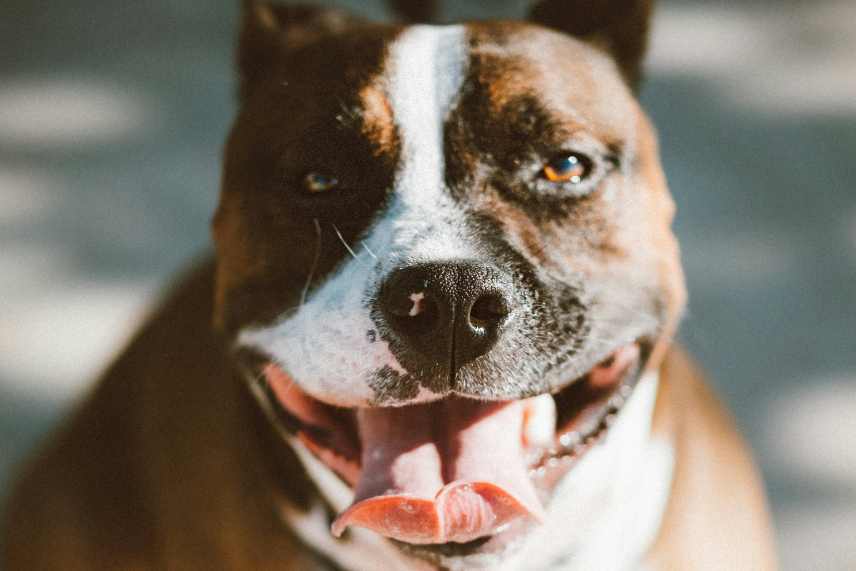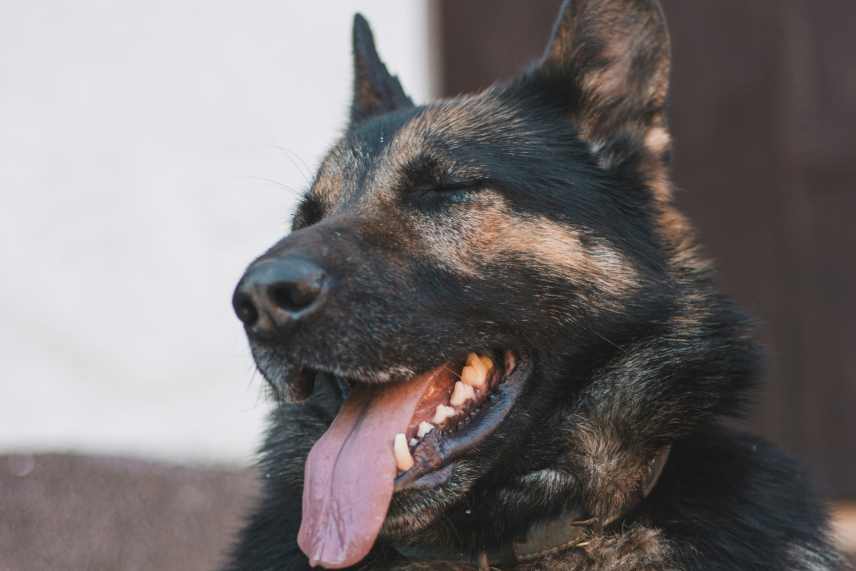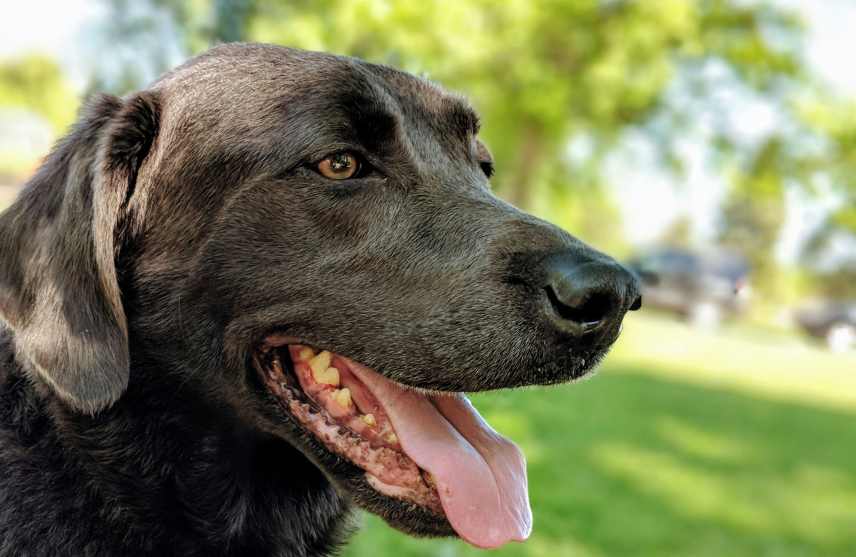Have you ever wondered why dogs stick their tongue out and drool? It’s a common sight to see our furry friends with their tongues hanging out, especially after a long walk or when they are excited. But why do dogs drool in the first place? In this article, we will explore the reasons behind this behavior and unravel the mysteries of drooling dogs.
Drooling is a natural response for dogs and serves various purposes. It helps them regulate their body temperature, especially when they’re overheated. Additionally, dogs use their tongues to release excess saliva, which can accumulate due to various factors such as eating, smelling delicious food, or feeling anxious or nauseous. For certain breeds with loose jowls, like St. Bernards or Bloodhounds, drooling is unavoidable due to their physical makeup.

Understanding the reasons behind drooling can help you better care for your canine companion and manage their drooling episodes. So, let’s dig deeper into the fascinating world of drooling dogs and gain insights into this quirky behavior.
Why Do Dogs Hang Their Tongue Out and Drool
Drooling is a natural response for dogs and serves various purposes. One of the primary reasons dogs drool is to regulate their body temperature. Unlike humans, dogs do not have sweat glands all over their bodies. Instead, they rely on panting and salivating to cool down.
When a dog is overheated, their body produces excess saliva, and sticking their tongue out helps to evaporate the moisture and cool them down. This is why you often see dogs panting with their tongues hanging out on hot summer days or after a vigorous exercise session.
Another reason dogs drool is to release excess saliva. Saliva production can be triggered by various factors such as eating, smelling delicious food, or feeling anxious or nauseous. Dogs use their tongues to expel the excess saliva from their mouths, preventing it from accumulating and causing discomfort.
So, the next time you see your dog drooling after catching a whiff of your dinner, you’ll know it’s their way of managing the excess saliva.
Common Triggers for Excessive Drooling in Dogs
While drooling is a natural and necessary behavior for dogs, excessive drooling can sometimes indicate an underlying issue. There are several common triggers that can cause dogs to drool excessively. One of the most common triggers is the presence of food or the anticipation of a meal.
Dogs are known for their love of food, and just the sight or smell of something delicious can cause them to salivate excessively. This is their way of getting ready to eat and can be seen as a sign of excitement or anticipation.
Another trigger for excessive drooling in dogs is stress or anxiety. Dogs can become anxious in various situations, such as during thunderstorms, fireworks, or when visiting the veterinarian. When dogs are stressed, their body produces more saliva as part of the fight-or-flight response. The excess saliva helps to protect their mouth and throat in case they need to defend themselves or escape from a threatening situation.
So, if you notice your dog drooling excessively in stressful situations, it’s important to provide them with comfort and reassurance.
Nausea or an upset stomach can also cause dogs to drool excessively. Just like humans, dogs can experience digestive issues that lead to nausea and vomiting. When dogs feel sick, their body produces more saliva as a protective mechanism. The excess saliva helps to neutralize stomach acid and soothe the digestive system.
If you notice your dog drooling excessively and showing other signs of stomach upset, such as vomiting or loss of appetite, it’s best to consult with a veterinarian to rule out any underlying health issues.
Health Conditions That May Cause Excessive Drooling
Excessive drooling can sometimes be a symptom of an underlying health condition in dogs. While occasional drooling is normal, if your dog’s drooling becomes excessive and persistent, it’s important to seek veterinary attention. Here are some health conditions that may cause dogs to drool excessively:
- Dental problems: Dental issues such as gum disease, tooth decay, or oral infections can lead to excessive drooling in dogs. The pain and discomfort caused by these conditions can cause dogs to produce more saliva as a protective response.
- Mouth or throat injuries: Injuries to the mouth or throat, such as cuts, burns, or foreign objects stuck in the mouth, can cause dogs to drool excessively. These injuries can be painful and may require immediate veterinary attention.
- Poisoning: Ingesting toxic substances can cause dogs to drool excessively as their body tries to eliminate the toxins. Common household items such as certain plants, cleaning products, or human medications can be toxic to dogs and should be kept out of their reach.
- Oral tumors: Tumors or growths in the mouth or throat can lead to excessive drooling in dogs. These tumors can interfere with the normal functioning of the salivary glands and cause an increase in saliva production.
- Nerve or muscle disorders: Certain nerve or muscle disorders can affect the normal functioning of the muscles involved in swallowing and salivating, leading to excessive drooling in dogs. Conditions such as megaesophagus or facial paralysis can cause difficulty in swallowing and result in excess saliva accumulation.
If you notice any abnormal or persistent drooling in your dog, it’s best to consult with a veterinarian to determine the underlying cause and provide appropriate treatment.
Breeds That Are More Prone to Drooling
While all dogs have the ability to drool, there are certain breeds that are more prone to excessive drooling due to their physical characteristics. These breeds often have loose jowls, wrinkled skin, and larger tongues, which make it difficult for them to keep their mouths closed and prevent saliva from escaping. Here are some dog breeds that are known for their drooling tendencies:
- St. Bernard: St. Bernards are large working dogs known for their gentle nature and rescue abilities. They have loose jowls and a large tongue, which leads to excessive drooling. If you’re considering adopting a St. Bernard, be prepared for their slobbery kisses and the need to keep a towel handy.
- Bloodhound: Bloodhounds are scent hounds with a keen sense of smell. They have loose skin around their face and neck, which contributes to their drooling tendencies. Bloodhounds are known for their tracking abilities and friendly personalities, but their drooling can be a challenge for some owners.
- Bulldog: Bulldogs are known for their distinctive wrinkled face and pushed-in nose. These features, combined with loose jowls, can lead to excessive drooling. Bulldogs are beloved for their gentle and affectionate nature, but their drooling can be a messy affair.
- Mastiff: Mastiffs are giant, powerful dogs with loose jowls and a large head. Their drooling tendencies are a result of their physical makeup. Despite their imposing size, Mastiffs are known for their gentle and loyal nature.
- Boxer: Boxers are energetic and playful dogs with a strong jaw and loose jowls. While they may not drool as much as some other breeds on this list, they can still be prone to occasional drooling, especially when they are excited or anticipating a meal.
If you’re considering adopting a dog from one of these breeds, it’s important to be prepared for their drooling tendencies and the extra care it may require to keep them clean and comfortable.
How to Manage Excessive Drooling in Dogs
While you may not be able to completely eliminate drooling in dogs, there are several ways to manage excessive drooling and keep your furry friend comfortable. Here are some tips to help you minimize the mess and ensure your dog’s well-being:
- Keep your dog’s mouth clean: Regular dental care is essential for preventing dental issues that can contribute to excessive drooling. Brush your dog’s teeth regularly using a dog-friendly toothbrush and toothpaste. Additionally, provide your dog with appropriate chew toys and dental treats to promote good oral hygiene.
- Use a drool bib or towel: If your dog is prone to excessive drooling, consider using a drool bib or placing a towel around their neck to catch the excess saliva. This can help keep your dog clean and prevent drool from getting on furniture or carpets.
- Provide a cool and comfortable environment: Dogs often drool more when they are overheated or anxious. Ensure that your dog has access to fresh water and a cool, shaded area during hot weather. If your dog becomes anxious in certain situations, such as during thunderstorms or fireworks, create a safe and comfortable space for them to retreat to.
- Address underlying health issues: If your dog’s drooling is excessive and persistent, it’s important to seek veterinary attention to rule out any underlying health conditions. Follow your veterinarian’s recommendations and administer any prescribed medications or treatments as directed.
- Be mindful of your dog’s diet: Certain foods or food allergies can contribute to excessive drooling in dogs. Pay attention to your dog’s diet and any potential triggers that may cause them to drool excessively. If you suspect a food allergy, consult with your veterinarian to determine the best diet for your dog.
Remember, excessive drooling can sometimes be a sign of a more serious underlying issue, so it’s important to consult with a veterinarian if you have any concerns about your dog’s drooling.
Tips for Preventing Excessive Drooling in Dogs
While you may not be able to prevent drooling altogether, there are some steps you can take to minimize excessive drooling in dogs. Here are some tips to help you keep your dog’s drooling under control:
- Avoid triggers: Pay attention to the situations or stimuli that cause your dog to drool excessively. If certain foods or scents trigger excessive drooling, try to avoid or minimize exposure to these triggers.
- Use distraction techniques: If your dog tends to drool excessively when they are anxious or stressed, try using distraction techniques to redirect their attention. Engage them in activities they enjoy, such as playing with their favorite toy or going for a walk, to help alleviate their anxiety.
- Practice good oral hygiene: Regular dental care is essential for preventing dental issues that can contribute to excessive drooling. Brush your dog’s teeth regularly, provide appropriate chew toys, and consider using dental treats or water additives to promote good oral hygiene.
- Keep your dog hydrated: Ensuring that your dog has access to fresh water at all times can help prevent dehydration and excessive drooling. Provide clean water in a spill-proof bowl and make sure to refill it regularly.
- Maintain a healthy weight: Obesity can contribute to a variety of health issues, including dental problems and respiratory difficulties, which can increase drooling in dogs. Help your dog maintain a healthy weight through a balanced diet and regular exercise.
Remember, every dog is unique, and what works for one dog may not work for another. It’s important to observe your dog’s behavior and consult with a veterinarian for personalized advice on managing excessive drooling.
When to Seek Veterinary Help for Excessive Drooling
While occasional drooling is normal for dogs, excessive and persistent drooling can sometimes indicate an underlying health issue that requires veterinary attention. Here are some signs that may indicate it’s time to seek veterinary help for your dog’s excessive drooling:
- Drooling that is accompanied by other symptoms such as vomiting, diarrhea, loss of appetite, or lethargy.
- Bleeding or sores in the mouth or throat.
- Difficulty swallowing or breathing.
- Swelling or lumps in the mouth or throat.
- Changes in behavior or temperament.
If you notice any of these signs or if you’re concerned about your dog’s excessive drooling, it’s best to consult with a veterinarian. They can perform a thorough examination, conduct any necessary tests, and provide appropriate treatment for your furry friend.
Myths and Misconceptions About Dog Drooling
There are several myths and misconceptions surrounding dog drooling. Let’s take a moment to debunk some of these common misconceptions:
- Myth: All dogs drool excessively. While drooling is a natural behavior for dogs, not all dogs drool excessively. The propensity to drool varies among breeds and individual dogs.
- Myth: Excessive drooling is always a sign of a serious health issue. While excessive drooling can sometimes indicate an underlying health issue, it doesn’t always mean something serious is wrong. Occasionally, excessive drooling can be a normal response to certain triggers or situations.
- Myth: Dogs drool only when they’re hungry. While the sight or smell of food can trigger excessive drooling in dogs, it’s not the only reason they drool. Dogs can drool for various reasons, including heat regulation, stress, or nausea.
- Myth: Dogs that don’t drool are healthier. The absence of drooling doesn’t necessarily indicate good health in dogs. Each dog is unique, and their drooling tendencies can vary based on breed, individual characteristics, and external factors.
- Myth: You can completely eliminate drooling in dogs. Drooling is a natural behavior for dogs, and while you can take steps to manage excessive drooling, it’s unlikely that you’ll be able to eliminate it completely. It’s important to embrace and understand your dog’s drooling tendencies as part of their individuality.
Conclusion: Understanding and Embracing Dog Drooling
Drooling is a fascinating and natural behavior for dogs. It serves various purposes, including body temperature regulation and saliva management. While some breeds are more prone to excessive drooling due to their physical characteristics, all dogs have the ability to drool to some extent. Understanding the reasons behind drooling can help you better care for your canine companion and manage their drooling episodes.
If your dog’s drooling becomes excessive or persistent, it’s important to seek veterinary attention to rule out any underlying health issues. Remember to provide a cool and comfortable environment for your dog, practice good oral hygiene, and be mindful of any triggers that may cause excessive drooling.
So, the next time you see your furry friend with their tongue hanging out and drooling, embrace their quirkiness and appreciate the fascinating world of dog drooling.
Unraveling the Mystery: Why Do Dogs Stick Their Tongue Out?

Dogs stick out their tongues for various reasons, such as cooling down through panting and sending relaxation signals. It could also indicate health concerns like oral issues or the impact of medications.
Understanding your dog’s behavior is essential to address any potential problems timely. By observing your pet’s tongue habits, you can enhance communication and training methods.
Continue reading: Why Do Dogs Stick Their Tongue Out?
Understanding Dog Panting and Restlessness: Causes and Remedies

Understanding why your dog is panting and restless is essential for ensuring their well-being and addressing any underlying health concerns. While occasional panting is normal, persistent or abnormal panting warrants attention and may indicate a need for veterinary evaluation.
Continue reading: Understanding Dog Panting and Restlessness
